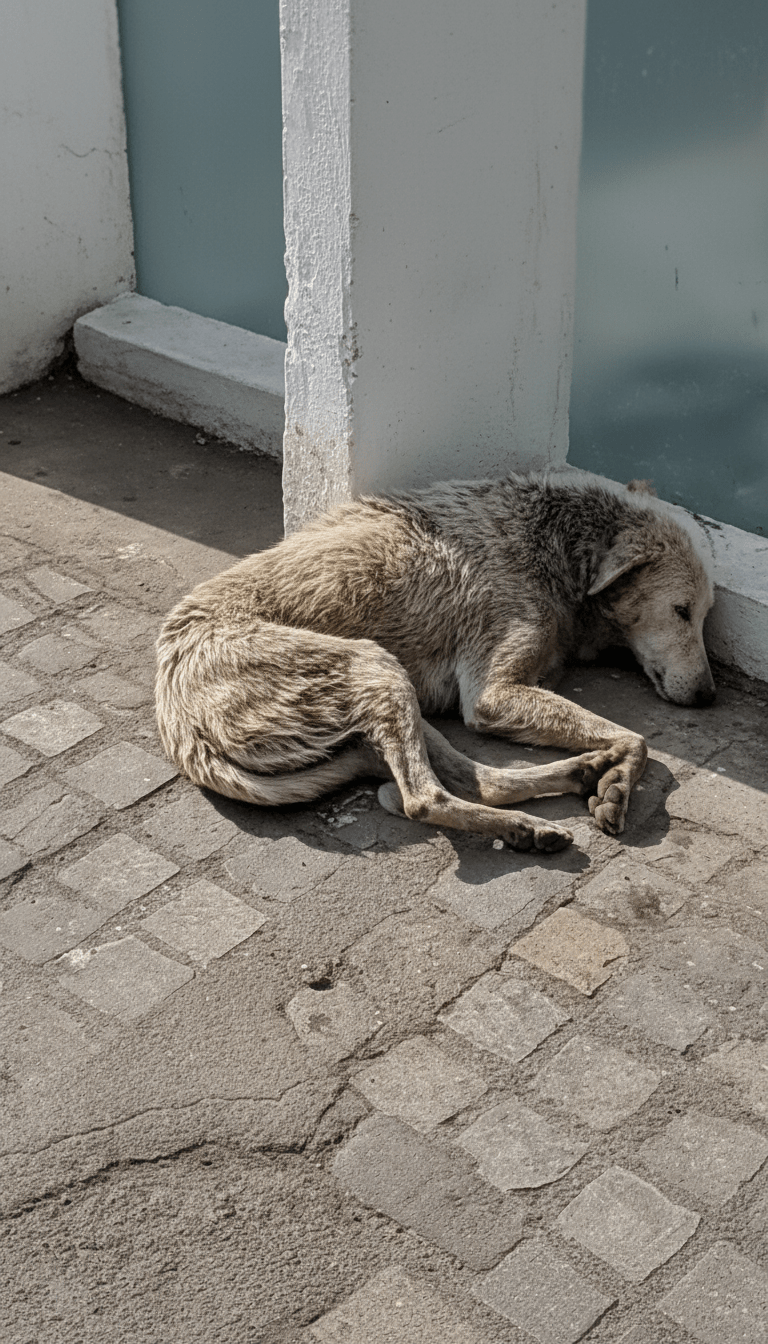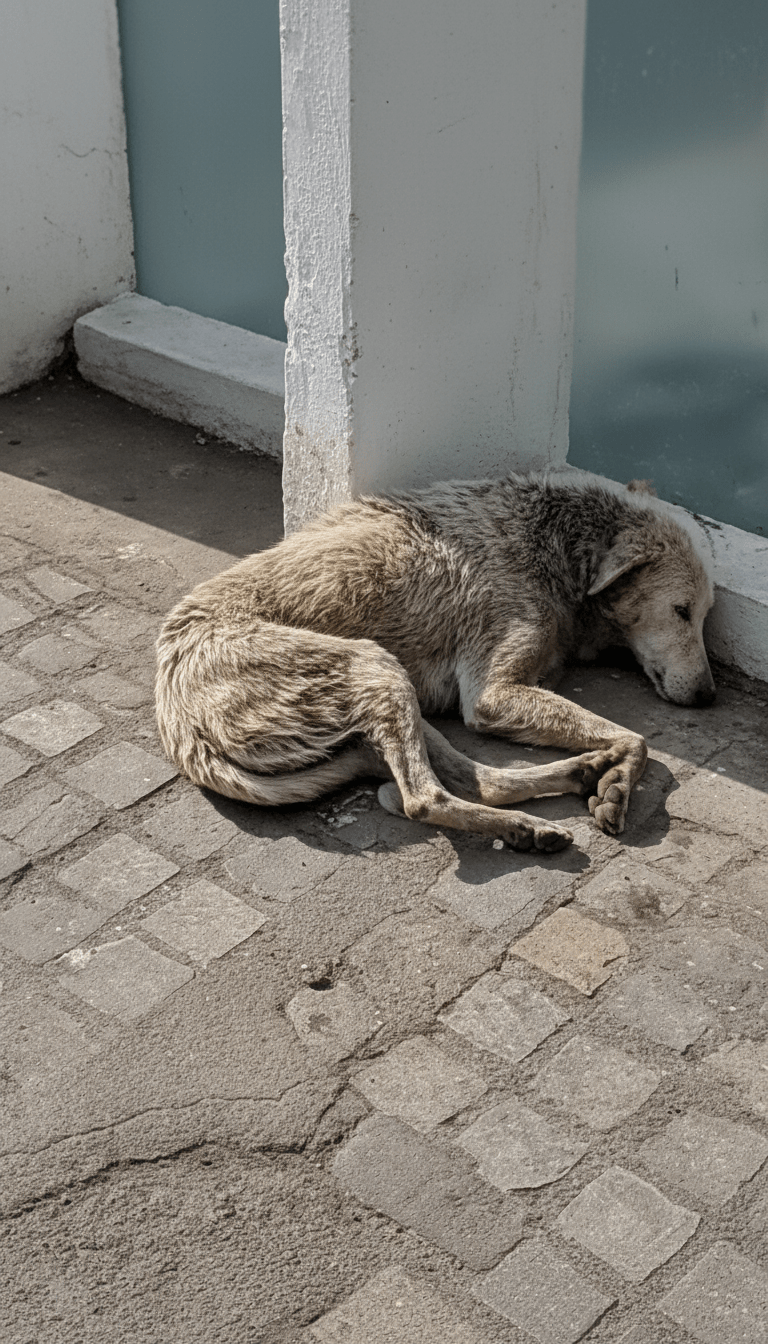In the blistering heat of a narrow alleyway in Udaipur, Rajasthan, a skeletal dog lay motionless against a cracked concrete pillar, his ribcage heaving with shallow, labored breaths that seemed to count down his final moments. Flies swarmed in thick clouds around a gaping, maggot-infested wound that stretched from his left shoulder to the middle of his back, the flesh torn open as if by a jagged blade. Passersby hurried past, averting their eyes from the stench of decay that mingled with the scent of street-side chai and frying samosas. No one stopped. No one dared touch the creature who appeared more corpse than canine. Yet, in a twist no one could have foreseen, a single phone call from a teenage shopkeeper—who had noticed the dog collapse three days earlier—set in motion a chain of events that would transform despair into one of the most astonishing recoveries ever documented by Animal Aid Unlimited, India’s renowned street animal rescue organization.

The call came at 2:17 p.m. on a sweltering July afternoon. Claire Abrams, a British volunteer who had arrived in Udaipur only a week earlier to study traditional Rajasthani miniature painting, was on dispatch duty that day. She scribbled the address on a scrap of paper, grabbed the rescue kit, and jumped into the ambulance with driver Rajesh and veteran rescuer Mohan. Traffic was a nightmare—rickshaws, cows, and tourists on scooters clogged the roads—but Rajesh maneuvered the van with the precision of a rally driver, honking through intersections while Claire clutched the door handle, her heart pounding. “I’ve seen bad cases,” Mohan muttered, “but the boy said this one hasn’t moved in three days. That’s usually the end.”
When they arrived, the scene was worse than described. The dog—later named Phoenix by the shelter staff—lay in a pool of his own pus and blood. His eyes were clouded with infection, and his tongue, swollen and cracked, lolled from the side of his mouth. Claire knelt beside him, gloved hands trembling as she assessed the wound. “He’s still warm,” she whispered, a flicker of hope cutting through her horror. Mohan slipped a muzzle over the dog’s snout—not out of fear of biting, but to protect the rescuers from the inevitable thrash of pain—and together they lifted the emaciated body onto a stretcher. Phoenix weighed less than 12 kilograms, his bones protruding like tent poles beneath matted fur.
Back at Animal Aid Unlimited’s sprawling sanctuary on the outskirts of the city, the veterinary team sprang into action. Dr. Priya Sharma, the lead surgeon, took one look at the wound and shook her head. “This isn’t a bite or a scratch,” she said, her voice steady but grave. “This is a machete wound. Someone tried to kill him.” The revelation sent a chill through the room. In rural Rajasthan, stray dogs are often seen as pests, and brutal attacks are not unheard of, but the precision of the cut suggested intent. Blood tests revealed severe anemia, dehydration, and a sky-high white blood cell count. Maggots had burrowed deep into the muscle tissue, and sepsis had already set in. “We have maybe 24 hours,” Dr. Sharma told the team. “If he survives the night, we’ll know he’s a fighter.”
The first night was a vigil. Phoenix was placed in the ICU kennel, hooked to IV fluids laced with broad-spectrum antibiotics. Veterinary nurse Arjun stayed by his side, changing dressings every two hours and syringing small amounts of electrolyte solution into his mouth. At 3:42 a.m., Phoenix’s temperature spiked to 105°F. The team plunged him into a lukewarm bath, a risky move that could send him into shock but was necessary to bring the fever down. Claire, unable to sleep, sat outside the kennel with a cup of chai gone cold, whispering encouragements through the bars. “Come on, boy. You’ve made it this far.”
Dawn brought the first miracle. Phoenix lifted his head. His eyes, though still cloudy, focused on Arjun’s face. He licked the nurse’s hand—a feeble, sandpaper swipe, but a sign of life. The team cheered quietly, afraid to jinx the fragile progress. Over the next week, the maggots were flushed out with meticulous daily cleanings, and the wound was packed with medical-grade honey, a traditional remedy that prevents infection and promotes tissue growth. Phoenix began to eat—first a slurry of boiled chicken and rice, then small pieces of chapati soaked in broth. His weight crept up: 12.5 kg, 13 kg, 14 kg.
But the road to recovery was far from smooth. On day ten, Phoenix developed a secondary infection in his lungs—aspiration pneumonia from inhaling food particles while too weak to swallow properly. He was intubated, a rare procedure for a street dog in India, and placed on a ventilator borrowed from a human hospital in Ahmedabad. The cost of the equipment rental alone exceeded the shelter’s monthly budget for antibiotics, but donations poured in after Animal Aid posted a plea on social media. A retired couple in Toronto sent $500 with a note: “For the dog who refuses to die.” A school in Mumbai organized a bake sale. Even a Bollywood actor shared the post, reaching millions.
By week three, Phoenix was standing. His legs wobbled like a newborn foal’s, but he took three steps toward the water bowl. The shelter staff cried openly. Physical therapy began—gentle walks on a leash, massage to rebuild atrophied muscles, and hydrotherapy in a kiddie pool filled with warm water. Claire, whose volunteer visa was nearing its end, extended her stay by a month. “I can’t leave him now,” she told her parents over a crackling video call. “He’s family.”

The most unexpected twist came during a routine checkup in week five. Dr. Sharma discovered a microchip embedded under Phoenix’s skin—a rarity for Indian strays. The chip traced back to a veterinary clinic in Jaipur, where a family had adopted a puppy named “Raju” three years earlier. The family had moved to Dubai, and Raju had escaped during a visit to relatives in Udaipur. The wound? A horrific accident with a garden tool, not an attack. The family, contacted via email, was overjoyed but unable to take Raju back due to quarantine laws. Instead, they funded his entire recovery and asked that he be adopted locally by someone who would love him as they once had.
Phoenix’s transformation became legend at the shelter. His fur grew back thick and golden, his eyes bright and alert. He learned to play fetch with a tennis ball, chasing it across the courtyard with a limp that only added to his charm. On the day of his discharge—exactly 73 days after rescue—over 200 people gathered to watch him walk out on a new leather leash donated by a local artisan. Claire, tears streaming down her face, knelt to fasten a collar around his neck. Etched on the tag were the words: “Phoenix—Survivor.”
Today, Phoenix lives with Mohan, the rescuer who carried him from the alley. He sleeps on a cushioned bed in the family’s courtyard, guards the gate with a gentle woof, and accompanies Mohan on rescue calls, as if to remind the team why they do this work. Animal Aid Unlimited has since installed a “Phoenix Fund” to cover critical-care cases, ensuring no dog is turned away for lack of funds. Claire returned to England but visits every year, bringing suitcases of treats and toys. And in Udaipur’s alleys, shopkeepers now call Animal Aid at the first sign of a suffering stray, whispering, “Don’t let another Phoenix slip away.”
The story of Phoenix is more than a rescue—it is a testament to the ripple effect of compassion. One phone call, one ambulance ride, one night of feverish hope, and a dog who should have died became a symbol of resilience across India and beyond. His journey reminds us that even in the darkest corners of the world, a single act of kindness can ignite a chain reaction of miracles.






